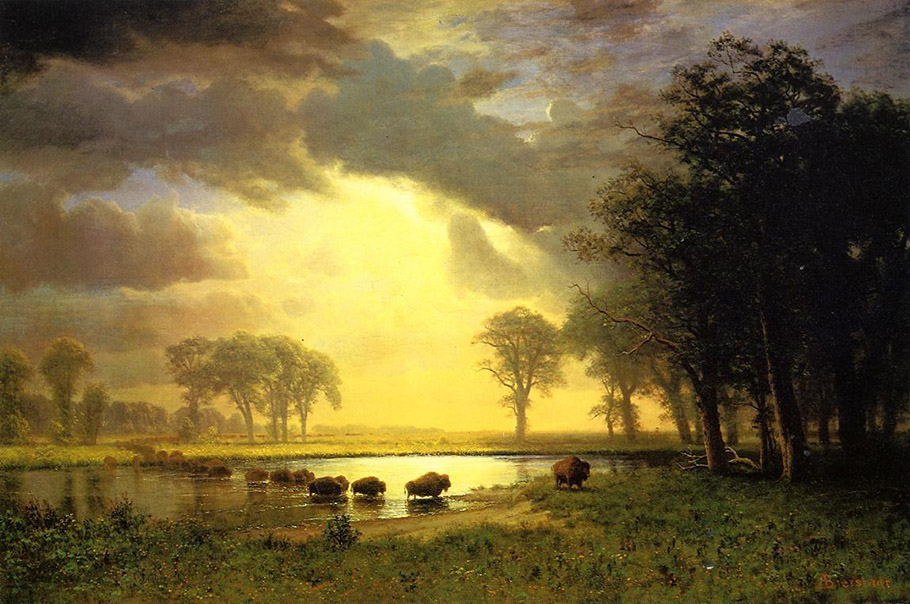Buffalo Trail – Albert Bierstadt
It is evening. An enormous buffalo herd narrows down to a single line. One by one, the buffalo cross a river somewhere in the American West. The first buffalo, likely a bull, walks on the shore. Far back in the distance, the rest of the herd moves toward the water.
This was the scene conceived in the mind of Albert Bierstadt in 1867. The same year that Bierstadt completes his painting the first typewriter is invented. Its keyboard will form the basis of those used in computers a century later.
The art experts will know that this is a work of the Hudson River School where nature is glorified in painting with an almost magical form of light. Beyond the light is the idea—the idea that nature is beauty, romantic, an expression of love that doesn’t require the presence of people.
Bierstadt argued with other painters in the Hudson River School over which time of day offered the truest light. He insisted it was dusk. Rivals said it was dawn.
No matter.
I’ve always been intrigued by this painting for its use of the buffalo.
The buffalo (really, the bison) symbolized American nature and had since early in the American Founding. Thomas Jefferson argued with French philosophers and natural scientists over the superiority of animals in America and Europe. Jefferson pointed to the buffalo as proof of American uniqueness.
In so doing, Jefferson wasn’t imagining. He lived through the buffalo’s existence east of the Mississippi River. For centuries down to the early nineteenth, the buffalo was commonplace in the Ohio River valley and further east. “The Buffalo Trace” was an extended trackway beaten down by millions of migrating buffalo in Illinois, Indiana, and Kentucky. A community in western New York took its name from the animal while Indiana placed the buffalo on its state seal. The meat and hides of the animal became popular in eastern markets.
But the Ohio and Mississippi Valleys didn’t keep the buffalo in the American imagination. The buffalo was an animal linked to way-out-there, distant from settlements. The nature of the buffalo was that it needed open spaces and the absence of farms, towns, and cities in order to survive. And so the identity of the animal narrowed from the national to the regional.
It was the West that deepened the buffalo imprint on the American image. European royalty and American industrialists paid exorbitant fees to travel west to the Great Plains to hunt the buffalo. They slaughtered them by the thousands. Political and military leaders in the American government identified the buffalo as a key resource for the control of several hostile Indian tribes. Many of these tribes organized their entire society and history around the animal. An American hunter, guide, and entrepreneur—William Cody—adopted the nickname of “Buffalo Bill” as he evolved from actual fact to quasi-legend in the West.
Popular culture in the twentieth century cemented the connection between the buffalo and the American West. The buffalo was a persistent part of most films called “westerns.” It also appeared in music, particularly the “western” half of country and western music. Authors of novels and stories set in the nineteenth-century American West included buffalo in their writing. From Larry McMurtry to Zane Grey, John Wayne to Robert Duvall, Bob Wills to Ghost Riders in the Sky, the buffalo was a standard backdrop of the West in popular culture.
I want to take you back to my earlier point about Bierstadt’s arguments with his peers in the Hudson River School. Remember that? Arguing over light, Bierstadt insisted that dusk was the best light to depict in painting. His peers thought dawn or morning the better time of light. One of their reasons for opposing Bierstadt’s view was that evening light seemed to them to be sad, melancholy. Bierstadt disagreed.
I think the sadness of Bierstadt’s painting is not in the light but in the animal. The buffalo. The buffalo seems fragile to us in the twenty-first century. Without governmental protection and special support, the buffalo would likely be extinct. It can’t exist without them. Its presence is, for us, a novelty. They exist in fences and set-aside areas. They are a natural symbol artificially maintained.
The buffalo strikes me as symbolic of retreat, withdrawal, a mournful flight in the face of modernity. It is always on the move as industrial and agricultural life march westward, westward, westward. The buffalo is historic, a living museum with four legs and a thick hide.
The animal is one of my favorites. It is one of the few to which I attach historical meaning. The buffalo appeals to me.
Two questions for you. Can you think of another animal that symbolizes an aspect of American history? Also, what animal would you choose to symbolize our own time, here in the passage to 2017?
I thank Albert Bierstadt for his magnificent work.








